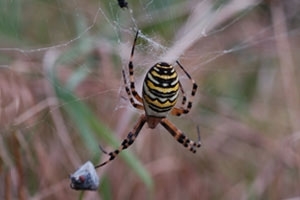Spiders
 A few years ago on a beautifully sunny and still October day, I stood at the entrance to a large arable field that had a freshly emerging cereal crop, but instead of being a bright green, the field appeared as a silvery shimmering “sea”. On closer inspection I discovered that the ground was completely covered in webs, to such an extent that the carpet it created changed the whole colour of the field. The spiders involved in creating this spectacle were money spiders, of which there are some 250 species in this country (around 640 UK species of spider in total) and they were preparing to go ballooning – not for fun as we do – but as a means of distributing themselves in new places.
A few years ago on a beautifully sunny and still October day, I stood at the entrance to a large arable field that had a freshly emerging cereal crop, but instead of being a bright green, the field appeared as a silvery shimmering “sea”. On closer inspection I discovered that the ground was completely covered in webs, to such an extent that the carpet it created changed the whole colour of the field. The spiders involved in creating this spectacle were money spiders, of which there are some 250 species in this country (around 640 UK species of spider in total) and they were preparing to go ballooning – not for fun as we do – but as a means of distributing themselves in new places.
The perfect conditions to witness such a spectacle is on a warm morning following a cold night, which results in air currents rising from the ground. Spiders take advantage of these conditions by climbing to the top of the highest thing they can find – in this case the leaves of the cereal crop. Once there, they release a strand of silk or “gossamer” from their abdomen, where spinnerets, their silk-spinning organs, are. The silk is so light that it acts as a balloon and as soon as the spider feels itself being lifted, it lets go. You might think that this unlikely mode of transport would only carry the tiny spider a short distance, before it crash lands in an adjacent field, but in fact in ideal conditions spiders can travel huge distances. Weather balloons positioned thousands of metres above the Hawaiian Islands, which are the remotest island group in the world, have recorded money spiders drifting by, most probably now thinking that it had been a bad idea to let go in the first place!
Britain actually holds the world record for the largest ever spider’s web, created by tiny little money spiders on Kineton High School’s playing fields in Warwickshire in October 1998. The cobweb was shown to cover the entire 11.2 acres and features in the Guinness Book of Records. This almost seems unbelievable, until you realise the population densities these spiders can reach, estimated to be up to 4,000,000 in just two and a half acres of ungrazed meadow.
The silk that spiders produce is amazing stuff – for instance it can stretch to one third of its original length without breaking, and weight for weight it is seven times stronger than steel. In fact, the US Army is investigating the possibility of using spiders’ silk to make bulletproof jackets as it is so strong and stretchy that it can absorb the impact of most bullets better than man-made fibres. The larger garden spider’s web contains on average around 30 metres of silk, and it will renew this structure every two days or so, eating the old silk and reusing it to create a new web. What is also really clever is that many spiders can produce two types of silk, thick and smooth for cocoon building, and sticky and elastic for web construction! Usually a central thread runs from the web back to the spider’s hiding place, so that it can feel any vibrations of a struggling fly, and rush out to claim its meal.
Peter Thompson
Advisory

Download Peter Thompson's essential 26-page book, featuring beautiful photography and detailed profiles of Britain's wildlife
Download FREE >